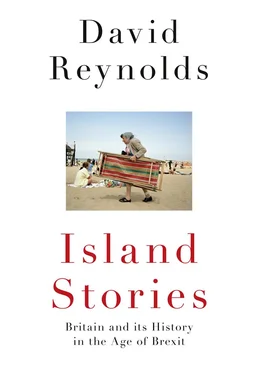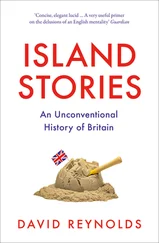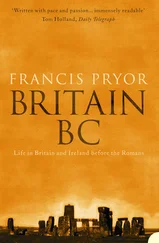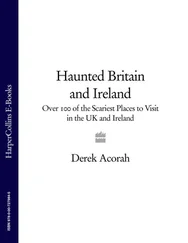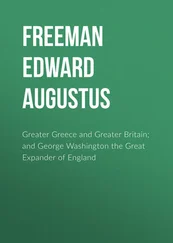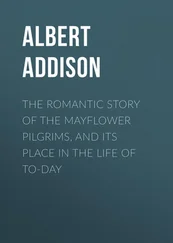To make some sense of these potted narratives we need to take in more than the Second World War and its aftermath, and look across the broad sweep of Gaitskell’s ‘thousand years’. An appropriate way to do so is by reflecting on the ‘English Channel’. Although this figures much less in the narratives of Welsh or Scottish history (defined by the Marches or the Borders) and hardly at all for Ireland (across the Irish Sea), the Channel has come to symbolise the Britain–Europe divide: a maritime frontier etched out in the White Cliffs of Dover. But we need a more fluid understanding of the Channel within ‘our island story’ – a more nuanced perspective on Britain’s changing interactions with a changing Continent.
The Channel – barrier and bridge
A millennium ago, what we British now call the English Channel was described as not so much a divide but a passageway between two land masses. Geoffrey of Monmouth, the twelfth-century chronicler, referred to it as ‘the straits to the south’ which ‘allow one to sail to Gaul’. [10] Конец ознакомительного фрагмента. Текст предоставлен ООО «ЛитРес». Прочитайте эту книгу целиком, купив полную легальную версию на ЛитРес. Безопасно оплатить книгу можно банковской картой Visa, MasterCard, Maestro, со счета мобильного телефона, с платежного терминала, в салоне МТС или Связной, через PayPal, WebMoney, Яндекс.Деньги, QIWI Кошелек, бонусными картами или другим удобным Вам способом.
His perspective was hardly surprising because, for several centuries after 1066, England was ruled by a political elite who spoke a version of French and who moved naturally between their domains on either side of the water. And in the age of sail, not rail, France could be reached from London far more quickly than Scotland. The result was ‘a shared culture’, ruled by an intermarried aristocracy and by the Roman Catholic Church, whose clerics constituted the administrative class (and also the historians). [11] Конец ознакомительного фрагмента. Текст предоставлен ООО «ЛитРес». Прочитайте эту книгу целиком, купив полную легальную версию на ЛитРес. Безопасно оплатить книгу можно банковской картой Visa, MasterCard, Maestro, со счета мобильного телефона, с платежного терминала, в салоне МТС или Связной, через PayPal, WebMoney, Яндекс.Деньги, QIWI Кошелек, бонусными картами или другим удобным Вам способом.
The sharing was, however, far from harmonious because of rival claims to territory and title. Armies from the French side of the Channel invaded England on several occasions, notably during the civil war of 1139–53 over the succession to Henry I and again in 1215–17 during the ‘Barons’ War’ against King John about how to interpret and implement the Magna Carta. More common, however, were armies crossing in the opposite direction, from north to south. After Henry I, the Anglo–Norman dynasty founded by William the Conqueror were succeeded by the descendants of Geoffrey of Anjou – Henry II and his sons Richard and John – whose ‘Angevin empire’ at its peak in the 1170s stretched in a great arc from Normandy west to encompass Brittany and then south down the coast to Bordeaux, Aquitaine and the Pyrenees, as well as east through the Massif Central to the Auvergne. Although covering about half of modern France, this ‘empire’ was a hodgepodge of separate possessions, plagued by disputes within Henry’s fractious family. It fell apart during the Anglo–French wars in John’s reign, with the loss of Normandy and all the other lands apart from Gascony, the southwest rump of the once vast duchy of Aquitaine.
Edward I and the Plantagenets struggled to hang on to what was left of their French lands. Their crucial claim was to the duchy of Aquitaine. The Capetian kings of France – engaged, like Edward I in Britain, in an aggressive programme of state building – claimed that, under the 1259 Treaty of Paris, the duchy could only be held in homage and fealty to the French crown. In 1286, Edward I did perform an act of homage to Philippe IV of France, using the words, ‘I become your man for the lands which I hold from you on this side of the sea according to the form of peace made between our ancestors.’ [12] Конец ознакомительного фрагмента. Текст предоставлен ООО «ЛитРес». Прочитайте эту книгу целиком, купив полную легальную версию на ЛитРес. Безопасно оплатить книгу можно банковской картой Visa, MasterCard, Maestro, со счета мобильного телефона, с платежного терминала, в салоне МТС или Связной, через PayPal, WebMoney, Яндекс.Деньги, QIWI Кошелек, бонусными картами или другим удобным Вам способом.
The implications of this vow became increasingly intolerable to his successors: a monarch who claimed to be sovereign on the English side of the sea was in a position of feudal inferiority to the Valois dynasty in respect of his continental inheritance. As the confrontation escalated, Edward III (the grandson of Edward I) took advantage of a French succession crisis in 1328 to assert his claim, via his mother, to rule France as well as England. The result was open warfare between the two monarchies on and off from 1337 – what became known as the Hundred Years’ War. After Henry V’s surprise victory at Agincourt in 1415, the English and their Burgundian allies did finally seem close to enforcing their claim. In the 1420s they controlled much of France from Brittany and the Channel to the Loire. But then the war turned against them, in part due to the inspirational leadership of Jeanne d’Arc, and by 1453 the English possessions were reduced to a small area around Calais. Despite new French wars under Henry VIII, Calais was eventually lost in 1558, though subsequent English monarchs did not stop reiterating their nominal claim to be rulers of France until the Napoleonic era.
Defeat in the Hundred Years’ War therefore ended a period of almost four centuries when the Channel was a bridge as much as a barrier, linking two sides of an Anglo–French culture in which the English elite had roots and often lands in France. Over the next four centuries there slowly emerged a sense of contrasting and competing national identities, sharpened by the Reformation and the protracted struggle to establish a distinctively English form of Protestantism, which lasted till 1690, and then by another on-off Hundred Years’ War with the French, this time against Louis XIV and later Napoleon. In this process, the Channel did assume the character of an iconic barrier, especially in official rhetoric.Yet it never ceased to function as a bridge because, as a Protestant nation, England could not be indifferent to the fate of the Reformation on the continent, now wracked by conflicts between Protestants and Catholics. [13] Конец ознакомительного фрагмента. Текст предоставлен ООО «ЛитРес». Прочитайте эту книгу целиком, купив полную легальную версию на ЛитРес. Безопасно оплатить книгу можно банковской картой Visa, MasterCard, Maestro, со счета мобильного телефона, с платежного терминала, в салоне МТС или Связной, через PayPal, WebMoney, Яндекс.Деньги, QIWI Кошелек, бонусными картами или другим удобным Вам способом.
Читать дальше
